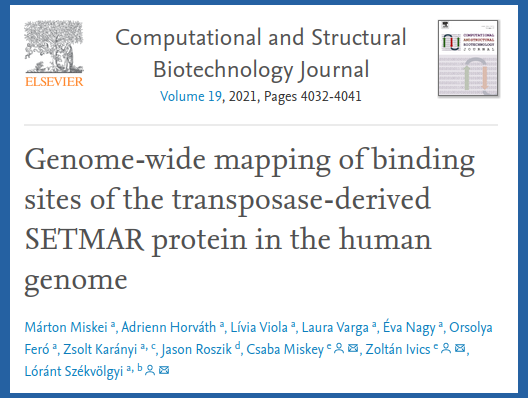New publication in CSBJ
New article has been published in Computational and Structural Biotechnology Journal:
Genome-wide mapping of binding sites of the transposase-derived SETMAR protein in the human genome
Márton Miskei, Adrienn Horváth, Lívia Viola, Laura Varga, Éva Nagy, Orsolya Feró, Zsolt Karányi, Jason Roszik, Csaba Miskey, Zoltán Ivics, Lóránt Székvölgyi
Abstract. Throughout evolution, DNA transposons provide a recurrent supply of genetic information to give rise to novel gene functions by fusion of their transposase domain to various domains of host-encoded proteins. One of these “domesticated”, transposase-derived factors is SETMAR/Metnase which is a naturally occurring fusion protein that consists of a histone-lysine methyltransferase domain and an HsMar1 transposase. To elucidate the biological role of SETMAR, it is crucial to identify genomic targets to which SETMAR specifically binds and link these sites to the regulation of gene expression. Herein, we mapped the genomic landscape of SETMAR binding in a near-haploid human leukemia cell line (HAP1) in order to identify on-target and off-target binding sites at high resolution and to elucidate their role in terms of gene expression. Our analysis revealed a perfect correlation between SETMAR and inverted terminal repeats (ITRs) of HsMar1 transposon remnants, which are considered as natural target sites for SETMAR binding. However, we did not detect any untargeted events at non-ITR sequences, calling into question previously proposed off-target binding sites. We identified sequence fidelity of the ITR motif as a key factor for determining the binding affinity of SETMAR for chromosomes, as higher conservation of ITR sequences resulted in increased affinity for chromatin and stronger repression of SETMAR-bound gene loci. These associations highlight how SETMAR’s chromatin binding fine-tune gene regulatory networks in human tumour cells.

 D5 Creation
D5 Creation